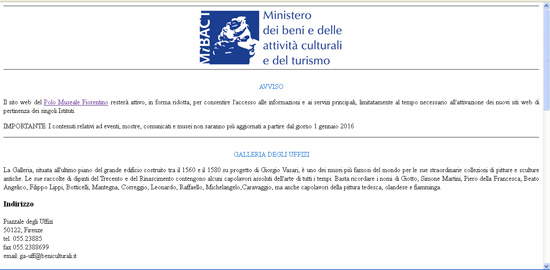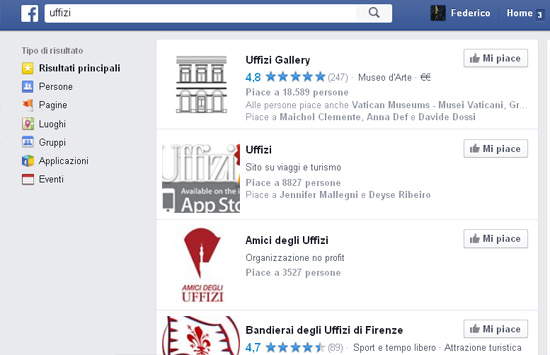The Uffizi on the web between lights and shadows: good projects but also lots of gaps and lack of clarity
I met Eike Schmidt in person toward the end of the year, when I interviewed him for Art and Dossier (the interview came out in shortened form in the January issue and the full interview will be posted online shortly): he gave me the impression that he is certainly a very competent and, above all, a very pragmatic person. And I am still convinced that, together with Antonio Natali, he will be able to do a very good job. After all, it was he himself who said that the current situation reminds him of the situation at the end of the 18th century, when the director was Giuseppe Pelli Bencivenni and the curator of the displays was Luigi Lanzi: one of the highest moments in the history of the museum. During my meeting with Eike Schmidt, we also touched on communication, particularly that of web communication. Schmidt told me that web communication is one of the main points of his strategy, but that there will be hard work to be done on it.
One cannot disagree with that. But it is also true that his adventure has not gotten off to the best start in this respect. These days, in fact, the sites of the museums that until before the reform of the Ministry made up the Polo Museale Fiorentino have become unreachable. And since in addition to the Uffizi all the other autonomous institutes are involved, I imagine that the directors are not to blame: it is difficult to think of a common choice so divorced from reality and especially from common sense. The museums’ websites (Uffizi, Galleria dell’Accademia, Palazzo Pitti, Bargello Museum, and all the others) have been replaced by single pages, devoid of any graphic formatting, in which only basic information about the institutes is given: opening hours, cost of tickets (with, fortunately, at least the link to buy them), contacts, two or three lines to describe what the visitor can find inside the museum. All of it solely in Italian: and if we consider the fact that Florentine museums have a very high number of foreign visitors, we can well realize the international figure that some of Italy’s most important museums are making. It did not take much to prepare little pages with the same information translated into English: taking into account that the information in English was already present on the now offline sites, it would only have been a matter of setting up, precisely, the individual pages. Given what is now being presented to us by the museums in Florence, this would have been a job that would have taken not an experienced web designer but any kid studying computer science in middle school half an hour.
 |
| Here is what the Uffizi website looks like these days |
A notice on the page that collects the links to the individual museums reads, “The Polo Museale Fiorentino website will remain active, in a reduced form, to allow access to the main information and services, limited to the time necessary for the activation of the new websites pertaining to the individual Institutes.” Now, the “reduced form” site has even been active since Tuesday: does it really take four days to make a switch from the old site to the new ones? What’s more, several sections of the old site (such as the press area, the events page, that of the education section) are actually still reachable: so wouldn’t it have been better to keep the websites of the individual museums active as well and then activate the new ones once they are ready? Indeed, web technologies make it possible to carry out such operations while limiting inconvenience to the public as much as possible: so it would be really interesting to understand how the technicians are handling the transition phase. Will we get any answers?
In any case, we have the impression that the museums of the former Polo Museale Fiorentino have always moved at two speeds. There are (and fortunately have not been shut down) really excellent online projects: think of Euploos, the computer catalog of the Gabinetto dei Disegni e delle Stampe degli Uffizi, which contains not only the inventory of a good part of the drawings in the collection, but also has a special section dedicated to the exhibitions held in the actual spaces and which includes digitizations of all the works on display, adequately annotated. Real online exhibitions invaluable to art lovers and scholars alike. And how can we fail to mention the online inventories, or the documentation center ’s site that contains an enormous amount of historical-critical information accompanying the works. Of course, it is all improvable: the photographs are of very poor quality, the online inventories have antediluvian navigation methods, an English version is lacking almost everywhere, and the Euploos project is far from complete, but at least, in terms of documentation, the road seems to be well marked out, and Schmidt’s ambitions (he intends to make all the works in the complex he directs available on the Web) bode well.
The really huge gaps are in the area of web communication aimed at the public. The museums of Florence do not have blogs, do not involve experts in the field, fail to tell their stories to the public, and do not promote themselves even on social networks: on Facebook, for example, the only pages that seem to be officially traceable to the Florentine museums (but I am not sure) have not been updated for years, and on the other hand, unofficial pages, often aimed at selling tickets on external circuits (and therefore at higher prices), often swarm, which are mistaken for the official pages. And this is also true for a variety of websites that use the Uffizi name and often end up before the official websites in Google search results. The only official Facebook page that has a link on the Uffizi website is that of the Polo Museale Fiorentino-a tragic choice, because the Polo brought together all the museums in Florence, and bringing together the activities of such a vast complex under a single page only contributed to confusion among visitors. Not least because a visitor from Sydney or Rio de Janeiro will have searched for “Uffizi” and not “Polo Museale Fiorentino” on Facebook-we hope at least that the new course ushered in by the MiBACT reform will lead to official pages for individual museums.
 |
| If we search for “Uffizi” on Facebook, these are the first results: it is not clear if there is an official page, and if so, it is not clear what it is |
Finally, Florentine museums could operate more controls on projects that can be traced back to them. Online for months now is the website for the Gold Unveiled project, a path through the ancient statues of the Uffizi designed “in order to embellish the display of certain works and make known the results of years of research on gilding.” On the website we read that the project “is conceived by Cristiana Barandoni, archaeologist and expert in communication and didactics of antiquity, in collaboration with Fabrizio Paolucci, Director of the Department of Classical Antiquity.” Of course, we are talking about the Department of Classical Antiquities of the Uffizi Gallery. Unfortunately, however, we also read texts that look a lot like copy-paste from various online sources, as we pointed out, complete with screenshots, in a post we published on our Facebook page. There is a need for the Uffizi to come clean: we think it is intolerable that such an important museum should accept that its name should be associated with projects that present themselves to the public in such an unprofessional way. Because it is clear that if a project presents itself as “designed in collaboration with the Director of the Department of Classical Antiquities of the Uffizi,” it comes naturally to tie the name of the museum to the project, and if the project does not meet minimum standards of content curation on the web, the museum’s image suffers as well. That is why, I repeat, clarity is needed.
So the intentions are very good. A lot has already been done in the past but, as seen above, we expect more: so there will have to be a turnaround from the past, there will have to be more care for the needs of the public, Florentine museums will have to understand that communication on the web is fundamental. It seems that Eike Schmidt feels the same way: we will just have to follow the evolution of the situation. We will certainly have much clearer ideas when the websites of the new autonomous institutes come online.
Warning: the translation into English of the original Italian article was created using automatic tools. We undertake to review all articles, but we do not guarantee the total absence of inaccuracies in the translation due to the program. You can find the original by clicking on the ITA button. If you find any mistake,please contact us.




























